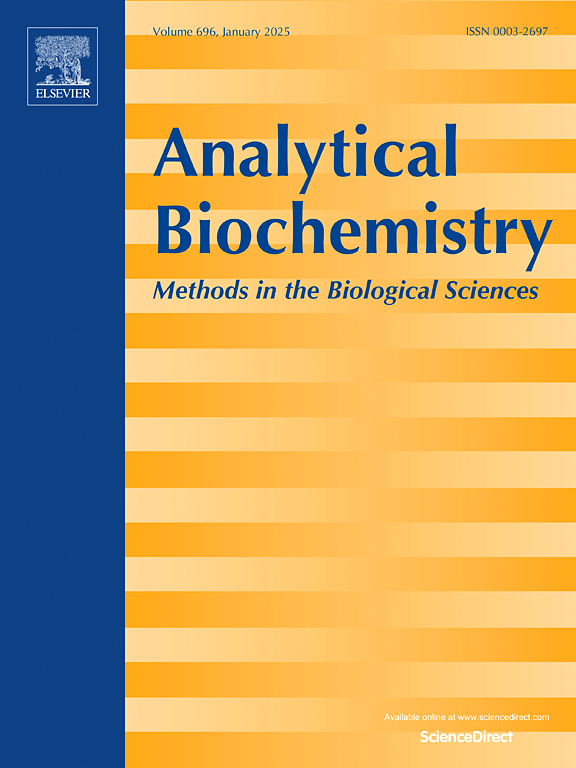Low-speed centrifugation based isolation and self-priming mediated chain extension based fluorescent quantification of Pseudomonas aeruginosa
IF 2.5
4区 生物学
Q2 BIOCHEMICAL RESEARCH METHODS
引用次数: 0
Abstract
Infections acquired at home and hospital are rather prevalent, and the incidence of these infections has been on the rise in recent years due to the growing elderly population. Infections caused by Pseudomonas aeruginosa (P. aeruginosa) pose a significant risk to human health and are prevalent among patients in hospitals and nursing homes. Consequently, it is imperative to devise an innovative and fluorescent method for analyzing P. aeruginosa to facilitate the early identification of home-acquired pneumonia. However, it is difficult to isolate and simultaneously quantify P. aeruginosa using most of the currently available methods. We present a novel platform that combines aptamer recognition-based aggregation of target bacteria with self-priming induced chain extension for signal amplification. This approach facilitates low-speed centrifugation-based isolation and simultaneous quantification of P. aeruginosa. The chain displacement procedure is incorporated for signal amplification, providing the approach with a broad detection range of six orders of magnitude and a low detection limit of 2.4 cfu/mL. In addition to its exceptional sensitivity, the method demonstrates commendable selectivity for the detection of P. aeruginosa, rendering it a viable instrument for identifying home-acquired pneumonia caused by P. aeruginosa and facilitating the early management of P. aeruginosa infections in the emergency department.

铜绿假单胞菌的低速离心分离及自引链延伸荧光定量。
在家庭和医院获得的感染相当普遍,近年来,由于老年人口不断增加,这些感染的发病率一直在上升。铜绿假单胞菌(P. aeruginosa)引起的感染对人类健康构成重大风险,在医院和疗养院的患者中普遍存在。因此,设计一种新颖的荧光分析方法来分析铜绿假单胞菌,以促进家庭获得性肺炎的早期识别势在必行。然而,使用目前大多数可用的方法很难分离和同时定量铜绿假单胞菌。我们提出了一个新的平台,结合了基于适体识别的目标细菌聚集和自引诱导的链扩展来进行信号放大。该方法有利于以低速离心为基础的铜绿假单胞菌的分离和同时定量。结合链位移过程进行信号放大,使该方法具有6个数量级的宽检测范围和2.4 cfu/mL的低检测限。除了其特殊的灵敏度外,该方法在铜绿假单胞菌检测方面表现出值得称赞的选择性,使其成为识别铜绿假单胞菌引起的家庭获得性肺炎的可行工具,并促进了急诊部门铜绿假单胞菌感染的早期管理。
本文章由计算机程序翻译,如有差异,请以英文原文为准。
求助全文
约1分钟内获得全文
求助全文
来源期刊

Analytical biochemistry
生物-分析化学
CiteScore
5.70
自引率
0.00%
发文量
283
审稿时长
44 days
期刊介绍:
The journal''s title Analytical Biochemistry: Methods in the Biological Sciences declares its broad scope: methods for the basic biological sciences that include biochemistry, molecular genetics, cell biology, proteomics, immunology, bioinformatics and wherever the frontiers of research take the field.
The emphasis is on methods from the strictly analytical to the more preparative that would include novel approaches to protein purification as well as improvements in cell and organ culture. The actual techniques are equally inclusive ranging from aptamers to zymology.
The journal has been particularly active in:
-Analytical techniques for biological molecules-
Aptamer selection and utilization-
Biosensors-
Chromatography-
Cloning, sequencing and mutagenesis-
Electrochemical methods-
Electrophoresis-
Enzyme characterization methods-
Immunological approaches-
Mass spectrometry of proteins and nucleic acids-
Metabolomics-
Nano level techniques-
Optical spectroscopy in all its forms.
The journal is reluctant to include most drug and strictly clinical studies as there are more suitable publication platforms for these types of papers.
 求助内容:
求助内容: 应助结果提醒方式:
应助结果提醒方式:


